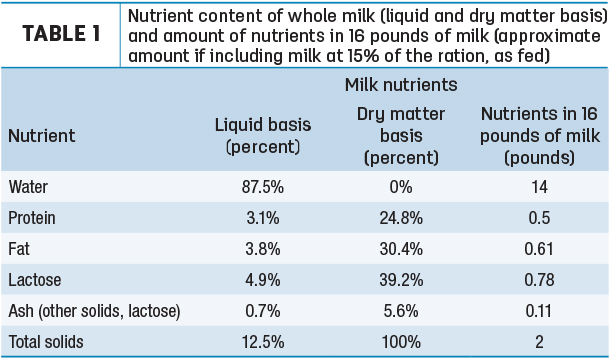Unfortunately, there are a limited number of options to deal with excess milk once its harvested – and even fewer with a positive outcome.
One of the options is dumping, previously discussed in a Progressive Dairy article. Whether land spreading, dumping into manure pits or processing through digesters, all require management steps to address environmental and regulatory concerns. (Read: Dumping milk? Consider these recommendations.)
Two University of Wisconsin-Madison Extension personnel, Matt Akins and Liz Binversie, recently published a fact sheet outlining other options. In addition to dumping, the list includes using excess milk to feed calves, heifers and even cows.
Before you start
Before undertaking any steps to incorporate unpasteurized milk into dairy cattle rations, Akins and Binversie recommend consulting with your nutritionist, veterinarian and other dairy advisers.
When it comes to feeding excess milk, there are several concerns:
-
Disease transfer. Akins and Binversie stress working with your veterinarian to determine disease risk. The long-term disease impact on herd health, reproduction and lower production could extend well past the timeline to dump milk. Any unpasteurized milk is a concern for spreading Johne’s disease, Mycoplasma, bovine leukosis (BLV), Staph aureus and other diseases. Use of on-farm pasteurizers to handle large volumes of milk probably isn’t possible or economically practical. If a pasteurizer is available, priority should be given to milk fed to young calves and heifers.
-
Moisture content. High water content (85%-88% water) limits the amount fed in a total mixed ration (TMR). Usage in TMR is similar to using water to reduce dry matter content (10%-15% of TMR as fed). This depends on the diet dry matter with potentially lower or higher inclusion for wetter or drier diets.
-
Milk storage and handling. Limited ability to store milk for longer than one day restricts possible usage. Pumps and hoses will be needed to move milk to the TMR mixer.
- Diet spoilage, odors and flies. Unpasteurized milk added to the TMR may cause unpleasant odors due to microbial growth, especially in warm weather. Monitoring of feed intake and the TMR for heating and smell is needed. Consider adding a TMR preservative to control microbial growth and spoilage. Flies will also become an issue when adding milk to a TMR, with a feed-through insect regulator useful to control fly populations. Feedbunk and equipment cleanliness is critical to minimize fly populations feeding on milk residues.
Also, check with state regulations. While states may allow milk to be utilized for animal feed on the farm where it was produced, distributing or selling it as animal feed to others may not be legal, unless the farm owner possesses a commercial feed license and the milk is labeled accordingly.
Feeding to dairy calves
Feeding waste milk to calves is already a common practice on many farms. If switching from milk replacer to waste milk, Akins and Binversie suggest making the change gradually to allow the calves to adapt. With excess milk supplies, producers may be able to delay weaning to allow increased milk feeding and a longer adjustment to starter grain. (Read: Pros and cons of feeding milk to calves and Whole-milk feeding made easy.)
Milk quality must be high, so keep bacterial loads low. Milk can be acidified with citric acid or preserved with potassium sorbate or sodium benzoate to minimize bacterial growth if not refrigerated. It is suggested to use acidified/preserved milk within three days to avoid excess bacterial growth. (Read: Feeding acidified milk to calves.)
Feeding to dairy heifers and lactating cows
Dairy farms utilizing a TMR may be able to include milk in the ration mix for dairy heifers and lactating cows. Feeding milk to dry and transition cows is generally not recommended due to heightened concerns with potentially reduced feed intake leading to metabolic problems (ketosis) around calving and early lactation, Akins said.
When feeding to heifers and lactating cows, inclusion rates of 10%-15%, as fed, will reduce the dry matter content of the ration by about 5 percentage units, Akins and Binversie advise.
At 15% of the ration (as fed), this would provide approximately 16 pounds milk or 2 pounds of milk solids (dry matter) per cow, or between 1,600-2,000 pounds of milk per 100 cows.
Milk inclusion should vary depending on the ration dry-matter content, with reduced inclusion in wetter rations. Ration dry matter should not be below 45%-50%, as this can restrict intake and will cause greater spoilage.
The ration must be balanced to account for the nutrients (fat, protein, lactose sugar and other nutrients) provided by the milk (Table 1).

When mixing and holding the TMR, monitor it for heating and odor. Ensure seepage of milk from the TMR is not occurring in the mixer or feedbunk – if so, reduce the inclusion rate. The increased moisture will lead to additional microbial growth. Check dry matter content of forages and the TMR more frequently, and closely monitor feed intakes as spoilage will reduce intakes. Consider using an acid preservative in the ration to limit spoilage.
Tim Thompson, senior dairy specialist with Provimi/Cargill, offers additional advice if incorporating surplus milk into a TMR. Due to heating and odor concerns in storage and in the feedbunk, he recommends mixing rations in smaller batches and feeding multiple times per day. Make sure bunks and the TMR mixer are cleaned regularly to prevent buildup of residues. That additional time and labor could negatively impact the economics of feeding milk in the TMR.
Find the fact sheet, Feeding Unpasteurized Milk to the Dairy Herd, on the University of Wisconsin Dairy Extension Resources website.
Assisted by John Goeser, Rock River Labs, Akins and Binversie have created an online Milk Nutrient Composition and Amount Calculator. ![]()
PHOTO: Staff photo.

-
Dave Natzke
- Editor
- Progressive Dairy
- Email Dave Natzke






